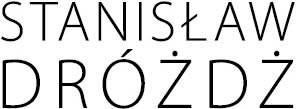

AUTHOR | WORK
in-between, Tadeusz Sławek
The word ‘in-between’ by Stanisław Dróżdż does not appear at any single time in a whole; the missing graphic sign must be always complemented by us ourselves. It is not, however, only an act of coquetry, filling the gap left by the artist. If it were, we might as well complement any space. However, in order to complement the work by Dróżdż we must definitely find ourselves within its borders. Not only do we add a missing sign in writing or in thoughts but, after all, while entering the space of this object we ourselves become the sign which fills the gap.
Let us recall the construction concept of in-between: the gallery (in this particular case it was a little room in Foksal Gallery in Warsaw) was covered with fabrics marked with particular letters of the word ‘in-between’ in regular squares appearing on the walls, the ceiling and the floor. As it has been mentioned above, these letters never form any articulate word but, simultaneously, they require us to make a certain movement which would enable the complementation of this word. Without our entering the space of the room, ‘in-between’ will be sentenced to dispersion and to an existence in the form of a disordered spill of words.
‘In-between’ will never achieve its destiny of being ‘in-between’ until we ourselves stand between its particular signs. However, on the other hand, unless we start the action among these dispersed signs of ‘between’, we will not be able to understand its meaning. We must get inside the word in order to let it show us the mechanisms which it is governed by. In fact, the centre of these mechanisms, which appears to be the purpose of their action, is to stop us before making the last step on the way to assemble the complete whole, a moment before the complete articulation of the sound of the word which would prevent us from being ‘in-between’ by putting us outside, beyond the elements suddenly concentrated in the whole being closed to us. If the reality is what exists between its elements, the extent of its non-readiness, fragmentariness and absence is the measure of its existence.
The world is one enormous absence, which means it contains all the possible absences. However, their sense and meaning depend on the distance and reciprocal incongruence of the objects. Being ‘in-between’ signifies being in the sphere of a constantly rejuvenating difference which prevents us from fully identifying the complete and complemented object. The state of being ‘in-between’ is the state of being permanently unready.
Therefore, also ‘I’ am subject to the forces operating ‘in-between’, those that weaken the customary confidence with which I approach the obviousness of my own existence. It does not suffice to stand among the objects in order to find ourselves ‘in-between’ them. What is indispensable is to realise that we ourselves are also the constructions which are, somehow, discontinuous. In order to fully comprehend the idea of being ‘in-between’, we have to reach the conclusion that this phenomenon does not occur outside us but, conversely, it itself constitutes the main element of our existence. According to Martin Buber: The Spirit does not exist in Me but between Me and You. It is not like blood which circulates in the veins but as the air we breathe with. The human being lives in Spirit when they are able to respond to the summons of their You.
[…]
Me as well as the object (the viewer and the letters forming the work by Dróżdż) do exist. It is not, however, a statement which imperiously closes us in two separate circles. Conversely, it focuses on what happens in-between us. In this sphere there are no settlements. The author does not leave any free space which would actually enable us to add any letter and make the word ‘in-between’ exist as a separate entity. What we can do is only approximate a settlement (but then it will, obviously, lose any trace of being a settlement) by entering the room where the artist placed these signs in order to make only our participation able to form the whole. This whole will disappear the moment we leave the space called ‘in-between’.
The whole which we referred to a while before will be nothing but illusory, a ‘flickering’ flash of the possibilities of the whole whose authenticity of surviving ‘in-between’ must be prevented in order to preserve for us the significance and reliability of being available fragmentarily as ‘in-between’. This ‘whole’ (which we will inevitably have to place in brackets) will be, then, only the form of an absence which is close and pulsates with meaning.
In fact, we exist only in-between us and the world.
A fragment of an essay The Art of Absence, [in:] Tadeusz Sławek, In-Between Letters, Wydawnictwo Dolnośląskie, Wrocław 1989.